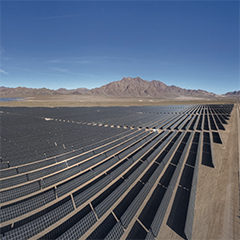Tracker company embraces large-format modules with their new single-axis tracker
FTC Solar has been preparing for over a year for the arrival of their next generation solar modules. These preparations are now paying off with the release of the new Voyager+ solar tracker, a robustly engineered, single-axis, two-in-portrait configuration that optimizes energy yields and takes full advantage of the larger, more powerful modules. One array built with large-format modules is already going into the ground as our teams work to deliver what will be among the first utility-scale projects in the U.S. utilizing the new technology.
‘We are honored to be part of these incredible projects,’ said Tony Etnyre, FTC Solar CEO. ‘We’re pleased that we can now support these exciting next generation modules with our innovative, two-in-portrait tracker systems. This, along with the industry-leading installation speeds of the Voyager tracker allows our customers to realize significant value in their solar projects.’
What is driving the adoption of large-format modules?
Solar manufacturing is entering into a new era with the introduction of high-power, high-performance modules. Likely to be integrated in the utility-scale market first, large-format modules (LFM) are a result of the drive to produce bigger silicon wafers. Large wafers expose more area to the sun and as the larger cells trap more light, that translates to a direct increase in the power of the module.
Solar manufacturers are in the process of replacing the current architecture of 72 cells per module at 156/166mm and introducing larger wafer sizes at 182mm and 210mm. In addition, they are slicing, dicing, shredding, and configuring new cell architectures to boost power output. One important result is bigger modules are evolving to house the larger wafers. While 500+ watt modules are entering the marketplace now, 600+ watt modules should be available later this year.
Tracker company embraces large-format modules with their new single-axis tracker
FTC Solar has been preparing for over a year for the arrival of their next generation solar modules. These preparations are now paying off with the release of the new Voyager+ solar tracker, a robustly engineered, single-axis, two-in-portrait configuration that optimizes energy yields and takes full advantage of the larger, more powerful modules. One array built with large-format modules is already going into the ground as our teams work to deliver what will be among the first utility-scale projects in the U.S. utilizing the new technology.
‘We are honored to be part of these incredible projects,’ said Tony Etnyre, FTC Solar CEO. ‘We’re pleased that we can now support these exciting next generation modules with our innovative, two-in-portrait tracker systems. This, along with the industry-leading installation speeds of the Voyager tracker allows our customers to realize significant value in their solar projects.’
What is driving the adoption of large-format modules?
Solar manufacturing is entering into a new era with the introduction of high-power, high-performance modules. Likely to be integrated in the utility-scale market first, large-format modules (LFM) are a result of the drive to produce bigger silicon wafers. Large wafers expose more area to the sun and as the larger cells trap more light, that translates to a direct increase in the power of the module.
Solar manufacturers are in the process of replacing the current architecture of 72 cells per module at 156/166mm and introducing larger wafer sizes at 182mm and 210mm. In addition, they are slicing, dicing, shredding, and configuring new cell architectures to boost power output. One important result is bigger modules are evolving to house the larger wafers. While 500+ watt modules are entering the marketplace now, 600+ watt modules should be available later this year.
To read the full content,
please download the PDF below.



























